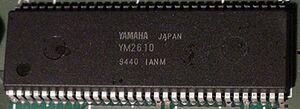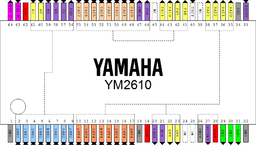YM2610: Difference between revisions
mNo edit summary |
|||
| Line 11: | Line 11: | ||
Sound can come from 3 different generators, each having their own channel(s): SSG, FM synthesis and ADPCM playback. | Sound can come from 3 different generators, each having their own channel(s): SSG, FM synthesis and ADPCM playback. | ||
=== SSG ( | === SSG (Software Sound Generator) === | ||
Given its limited capacities, the SSG is more often used for simple sound effects (coin sound, cursors in menus...) rather than music. | Given its limited capacities, the SSG is more often used for simple sound effects (coin sound, cursors in menus...) rather than music. | ||
Revision as of 12:58, 20 October 2016

The YM2610 is a sound synthesis and playback chip made by Yamaha, which is used in all versions of the NeoGeo hardware. It was later merged with the Z80 subsystem in the NEO-YSA and NEO-YSA2 chips, which are used on some versions of the NeoGeo CD, CDZ and on ROM-Only boards.
The chip relies on a YM3016 external DAC (Digital to Analog Converter) chip for the FM and ADPCM sounds. The only direct analog output is for the SSG sounds. Both analog outputs are then mixed together before amplification.
The original YM2610 chip gets quite warm during normal operation.
Sound generation parts
Sound can come from 3 different generators, each having their own channel(s): SSG, FM synthesis and ADPCM playback.
SSG (Software Sound Generator)
Given its limited capacities, the SSG is more often used for simple sound effects (coin sound, cursors in menus...) rather than music.
The SSG has 3 square wave channels with programmable frequency, and a LFSR noise channel, all with programmable amplitude. An unique enveloppe generator with predefined shapes can also be linked to the SSG's channels amplitudes.
FM (Frequency Modulation)
The FM part has 4 channels, each having their own operators, panning and amplitude values. It's the most used way of producing music in games.
ADPCM (Adaptive Differential Pulse-Code Modulation)
APDCM playback allows sampled sounds stored in the V ROMs or PCM files to be played. It's used for anything that can't be easily synthesized like voices, percussions and wind instruments.
The ADPCM-A part has 6 channels, and a fixed playback frequency of: 8MHz (main clock) / 12 (prescaler) / 6 clocks per access / 6 channels = 18.5185kHz.
Audio is compressed as 4bit per sample and played back as 12bit.
The ADPCM-B part only has 1 channel, but the playback frequency can be changed from 1.85kHz to: 18.5185 * 3 (1 access every 2 ADPCM-A channel access max) = 55.555kHz.
Audio is compressed as 4bit per sample and played back as 16bit.
Samples can be any size from 256 bytes to 1MiB, in 256 bytes steps. Samples cannot cross 1MB pages (the 4 MSBs of the end address should be equal to the start address).
See YM2610 registers: ADPCM-A and ADPCM-B
CPU communication
See Z80/YM2610 interface.
Multiplexed PCM bus

Access to the V ROMs are made via partly multiplexed buses. See YM2610 bus timing for more details about the access sequences.
The SDRMPX and SDPMPX signals are used to drive latches or the PCM chip in cartridges to demultiplex data. When SDROE or SDPOE goes low, SDRAD* and SDPAD* are tristated so that the V ROMs can output data.
- SDRA* for ADPCM-A
| SDRMPX | SDRAD* | SDRA* | ||||||||||||
|---|---|---|---|---|---|---|---|---|---|---|---|---|---|---|
| 0 | 1 | 2 | 3 | 4 | 5 | 6 | 7 | 8 | 9 | 20 | 21 | 22 | 23 | |
| Low to high | 0 | 1 | 2 | 3 | 4 | 5 | 6 | 7 | 8 | 9 | ? | ? | ? | ? |
| High to low | 10 | 11 | 12 | 13 | 14 | 15 | 16 | 17 | 18 | 19 | 20 | 21 | 22 | 23 |
- SDPA* for ADPCM-B
| SDPMPX | SDPAD* | SDPA* | ||||||||||||
|---|---|---|---|---|---|---|---|---|---|---|---|---|---|---|
| 0 | 1 | 2 | 3 | 4 | 5 | 6 | 7 | 8 | 9 | 10 | 11 | |||
| Low to high | 0 | 1 | 2 | 3 | 4 | 5 | 6 | 7 | 8 | 9 | 10 | 11 | ||
| High to low | 12 | 13 | 14 | 15 | 16 | 17 | 18 | 19 | 20 | 21 | 22 | 23 | ||
24 bits allow for 16MiB max V ROMs (without bankswitching).
Trivia
- A lot of games have several recordings of the same instrument playing different notes, rather than having only one sample and change the ADPCM-B playback frequency to vary its pitch. (Trumpet in Viewpoint, electric guitar in Super Sidekicks). Why ?
- Nazca's sound drivers are able to use the SSG channels for music playback. (Maybe all can ?)
Datasheet
Incomplete/translated datasheet: [YM2610.pdf]